Big Data Analysis: Challenges, Techniques, and Business Applications
VerifiedAdded on 2023/06/14
|6
|1945
|120
Report
AI Summary
This report provides a comprehensive overview of big data technology, including its characteristics, challenges, available techniques for analysis, and its potential to support business decision-making. It defines big data, highlighting its volume, variety, veracity, velocity, and value. The report identifies key challenges such as the lack of skilled professionals, data growth issues, integrating data from disparate sources, and data security. It discusses techniques like A/B testing, machine learning, statistics, and natural language processing used in big data analytics. Furthermore, it explains how big data technology can support business by improving customer acquisition and retention, and aiding in risk management. The report concludes that big data improves business performance and offers a competitive advantage.
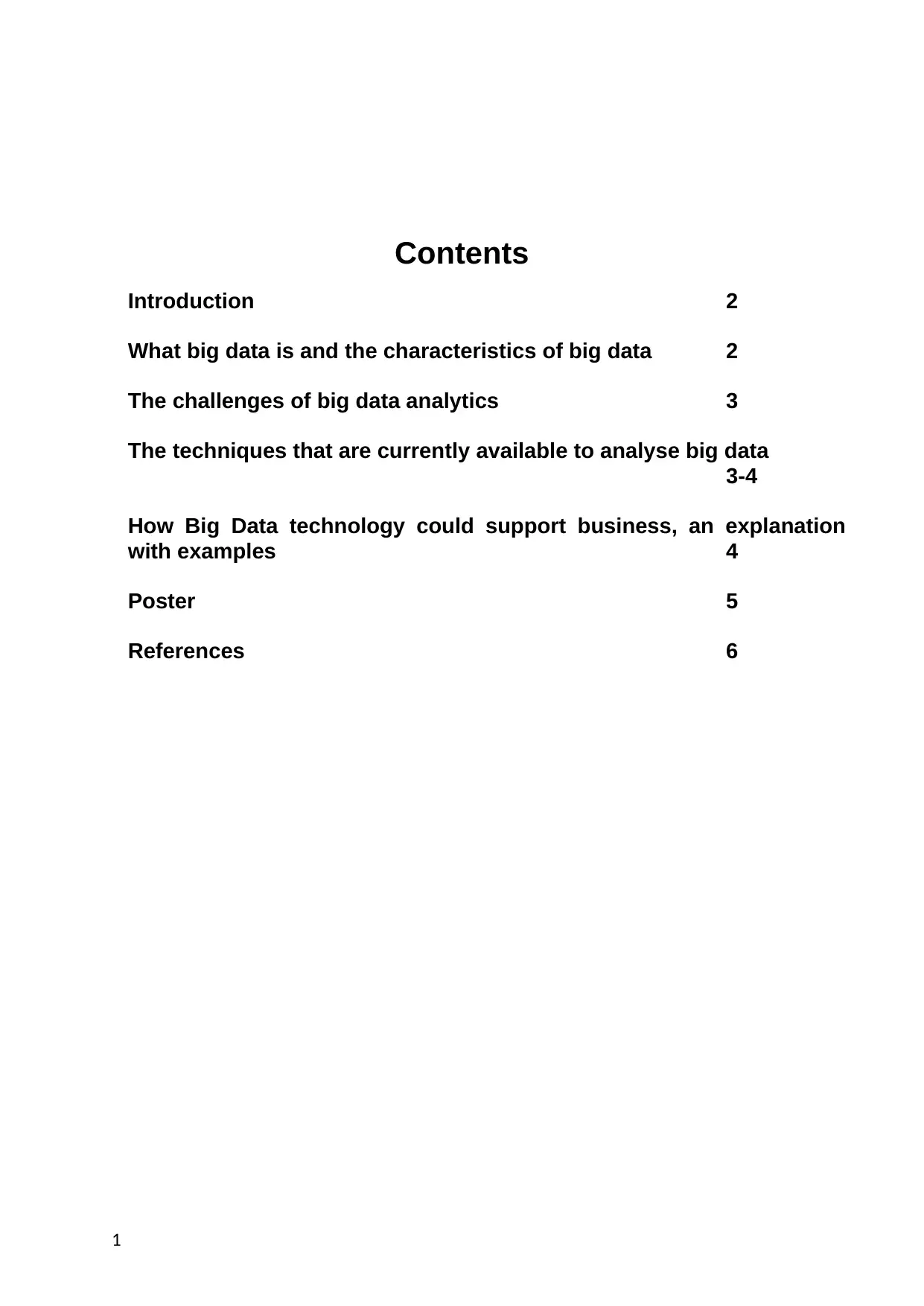
Contents
Introduction 2
What big data is and the characteristics of big data 2
The challenges of big data analytics 3
The techniques that are currently available to analyse big data
3-4
How Big Data technology could support business, an explanation
with examples 4
Poster 5
References 6
1
Introduction 2
What big data is and the characteristics of big data 2
The challenges of big data analytics 3
The techniques that are currently available to analyse big data
3-4
How Big Data technology could support business, an explanation
with examples 4
Poster 5
References 6
1
Paraphrase This Document
Need a fresh take? Get an instant paraphrase of this document with our AI Paraphraser
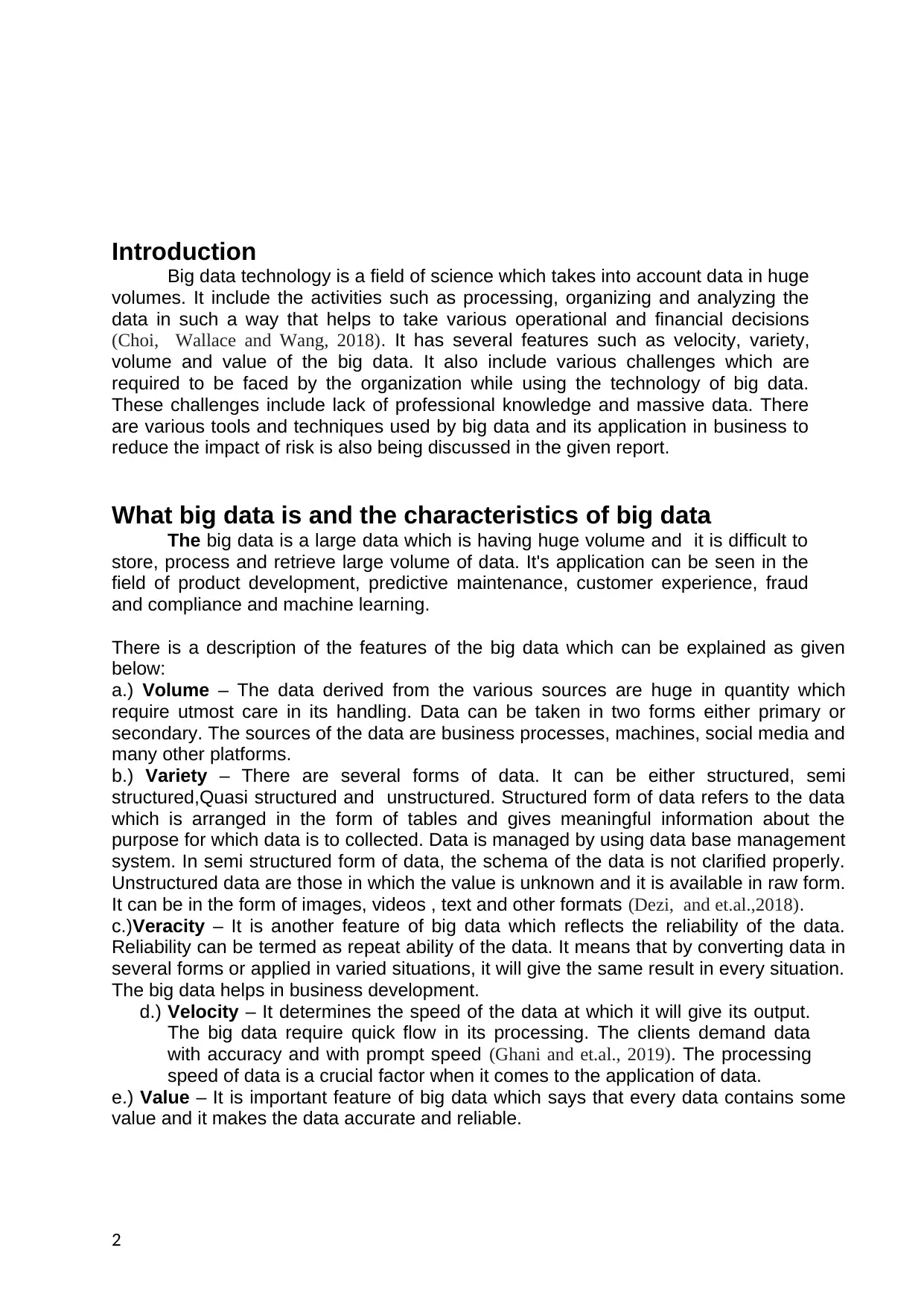
Introduction
Big data technology is a field of science which takes into account data in huge
volumes. It include the activities such as processing, organizing and analyzing the
data in such a way that helps to take various operational and financial decisions
(Choi, Wallace and Wang, 2018). It has several features such as velocity, variety,
volume and value of the big data. It also include various challenges which are
required to be faced by the organization while using the technology of big data.
These challenges include lack of professional knowledge and massive data. There
are various tools and techniques used by big data and its application in business to
reduce the impact of risk is also being discussed in the given report.
What big data is and the characteristics of big data
The big data is a large data which is having huge volume and it is difficult to
store, process and retrieve large volume of data. It's application can be seen in the
field of product development, predictive maintenance, customer experience, fraud
and compliance and machine learning.
There is a description of the features of the big data which can be explained as given
below:
a.) Volume – The data derived from the various sources are huge in quantity which
require utmost care in its handling. Data can be taken in two forms either primary or
secondary. The sources of the data are business processes, machines, social media and
many other platforms.
b.) Variety – There are several forms of data. It can be either structured, semi
structured,Quasi structured and unstructured. Structured form of data refers to the data
which is arranged in the form of tables and gives meaningful information about the
purpose for which data is to collected. Data is managed by using data base management
system. In semi structured form of data, the schema of the data is not clarified properly.
Unstructured data are those in which the value is unknown and it is available in raw form.
It can be in the form of images, videos , text and other formats (Dezi, and et.al.,2018).
c.)Veracity – It is another feature of big data which reflects the reliability of the data.
Reliability can be termed as repeat ability of the data. It means that by converting data in
several forms or applied in varied situations, it will give the same result in every situation.
The big data helps in business development.
d.) Velocity – It determines the speed of the data at which it will give its output.
The big data require quick flow in its processing. The clients demand data
with accuracy and with prompt speed (Ghani and et.al., 2019). The processing
speed of data is a crucial factor when it comes to the application of data.
e.) Value – It is important feature of big data which says that every data contains some
value and it makes the data accurate and reliable.
2
Big data technology is a field of science which takes into account data in huge
volumes. It include the activities such as processing, organizing and analyzing the
data in such a way that helps to take various operational and financial decisions
(Choi, Wallace and Wang, 2018). It has several features such as velocity, variety,
volume and value of the big data. It also include various challenges which are
required to be faced by the organization while using the technology of big data.
These challenges include lack of professional knowledge and massive data. There
are various tools and techniques used by big data and its application in business to
reduce the impact of risk is also being discussed in the given report.
What big data is and the characteristics of big data
The big data is a large data which is having huge volume and it is difficult to
store, process and retrieve large volume of data. It's application can be seen in the
field of product development, predictive maintenance, customer experience, fraud
and compliance and machine learning.
There is a description of the features of the big data which can be explained as given
below:
a.) Volume – The data derived from the various sources are huge in quantity which
require utmost care in its handling. Data can be taken in two forms either primary or
secondary. The sources of the data are business processes, machines, social media and
many other platforms.
b.) Variety – There are several forms of data. It can be either structured, semi
structured,Quasi structured and unstructured. Structured form of data refers to the data
which is arranged in the form of tables and gives meaningful information about the
purpose for which data is to collected. Data is managed by using data base management
system. In semi structured form of data, the schema of the data is not clarified properly.
Unstructured data are those in which the value is unknown and it is available in raw form.
It can be in the form of images, videos , text and other formats (Dezi, and et.al.,2018).
c.)Veracity – It is another feature of big data which reflects the reliability of the data.
Reliability can be termed as repeat ability of the data. It means that by converting data in
several forms or applied in varied situations, it will give the same result in every situation.
The big data helps in business development.
d.) Velocity – It determines the speed of the data at which it will give its output.
The big data require quick flow in its processing. The clients demand data
with accuracy and with prompt speed (Ghani and et.al., 2019). The processing
speed of data is a crucial factor when it comes to the application of data.
e.) Value – It is important feature of big data which says that every data contains some
value and it makes the data accurate and reliable.
2
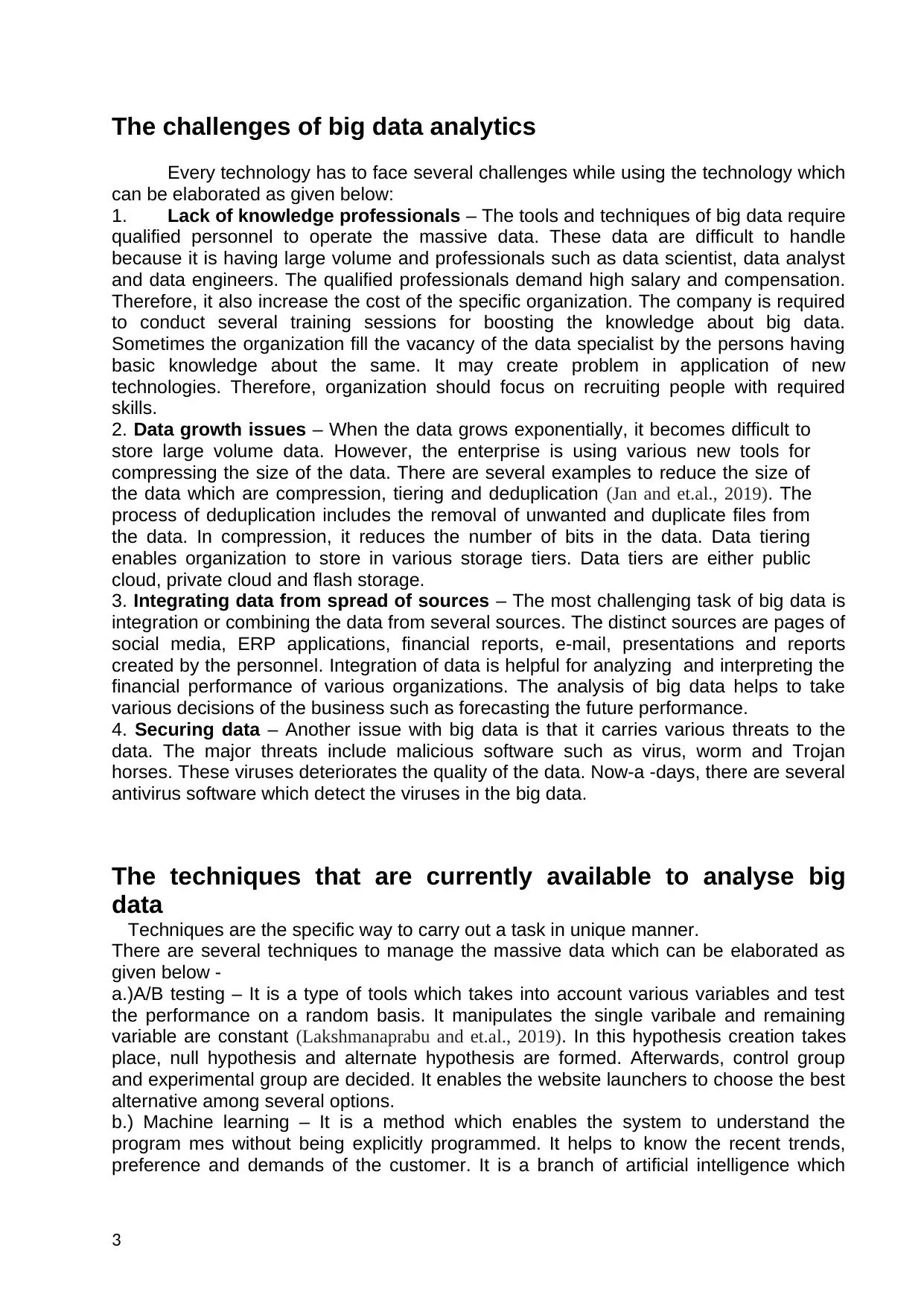
The challenges of big data analytics
Every technology has to face several challenges while using the technology which
can be elaborated as given below:
1. Lack of knowledge professionals – The tools and techniques of big data require
qualified personnel to operate the massive data. These data are difficult to handle
because it is having large volume and professionals such as data scientist, data analyst
and data engineers. The qualified professionals demand high salary and compensation.
Therefore, it also increase the cost of the specific organization. The company is required
to conduct several training sessions for boosting the knowledge about big data.
Sometimes the organization fill the vacancy of the data specialist by the persons having
basic knowledge about the same. It may create problem in application of new
technologies. Therefore, organization should focus on recruiting people with required
skills.
2. Data growth issues – When the data grows exponentially, it becomes difficult to
store large volume data. However, the enterprise is using various new tools for
compressing the size of the data. There are several examples to reduce the size of
the data which are compression, tiering and deduplication (Jan and et.al., 2019). The
process of deduplication includes the removal of unwanted and duplicate files from
the data. In compression, it reduces the number of bits in the data. Data tiering
enables organization to store in various storage tiers. Data tiers are either public
cloud, private cloud and flash storage.
3. Integrating data from spread of sources – The most challenging task of big data is
integration or combining the data from several sources. The distinct sources are pages of
social media, ERP applications, financial reports, e-mail, presentations and reports
created by the personnel. Integration of data is helpful for analyzing and interpreting the
financial performance of various organizations. The analysis of big data helps to take
various decisions of the business such as forecasting the future performance.
4. Securing data – Another issue with big data is that it carries various threats to the
data. The major threats include malicious software such as virus, worm and Trojan
horses. These viruses deteriorates the quality of the data. Now-a -days, there are several
antivirus software which detect the viruses in the big data.
The techniques that are currently available to analyse big
data
Techniques are the specific way to carry out a task in unique manner.
There are several techniques to manage the massive data which can be elaborated as
given below -
a.)A/B testing – It is a type of tools which takes into account various variables and test
the performance on a random basis. It manipulates the single varibale and remaining
variable are constant (Lakshmanaprabu and et.al., 2019). In this hypothesis creation takes
place, null hypothesis and alternate hypothesis are formed. Afterwards, control group
and experimental group are decided. It enables the website launchers to choose the best
alternative among several options.
b.) Machine learning – It is a method which enables the system to understand the
program mes without being explicitly programmed. It helps to know the recent trends,
preference and demands of the customer. It is a branch of artificial intelligence which
3
Every technology has to face several challenges while using the technology which
can be elaborated as given below:
1. Lack of knowledge professionals – The tools and techniques of big data require
qualified personnel to operate the massive data. These data are difficult to handle
because it is having large volume and professionals such as data scientist, data analyst
and data engineers. The qualified professionals demand high salary and compensation.
Therefore, it also increase the cost of the specific organization. The company is required
to conduct several training sessions for boosting the knowledge about big data.
Sometimes the organization fill the vacancy of the data specialist by the persons having
basic knowledge about the same. It may create problem in application of new
technologies. Therefore, organization should focus on recruiting people with required
skills.
2. Data growth issues – When the data grows exponentially, it becomes difficult to
store large volume data. However, the enterprise is using various new tools for
compressing the size of the data. There are several examples to reduce the size of
the data which are compression, tiering and deduplication (Jan and et.al., 2019). The
process of deduplication includes the removal of unwanted and duplicate files from
the data. In compression, it reduces the number of bits in the data. Data tiering
enables organization to store in various storage tiers. Data tiers are either public
cloud, private cloud and flash storage.
3. Integrating data from spread of sources – The most challenging task of big data is
integration or combining the data from several sources. The distinct sources are pages of
social media, ERP applications, financial reports, e-mail, presentations and reports
created by the personnel. Integration of data is helpful for analyzing and interpreting the
financial performance of various organizations. The analysis of big data helps to take
various decisions of the business such as forecasting the future performance.
4. Securing data – Another issue with big data is that it carries various threats to the
data. The major threats include malicious software such as virus, worm and Trojan
horses. These viruses deteriorates the quality of the data. Now-a -days, there are several
antivirus software which detect the viruses in the big data.
The techniques that are currently available to analyse big
data
Techniques are the specific way to carry out a task in unique manner.
There are several techniques to manage the massive data which can be elaborated as
given below -
a.)A/B testing – It is a type of tools which takes into account various variables and test
the performance on a random basis. It manipulates the single varibale and remaining
variable are constant (Lakshmanaprabu and et.al., 2019). In this hypothesis creation takes
place, null hypothesis and alternate hypothesis are formed. Afterwards, control group
and experimental group are decided. It enables the website launchers to choose the best
alternative among several options.
b.) Machine learning – It is a method which enables the system to understand the
program mes without being explicitly programmed. It helps to know the recent trends,
preference and demands of the customer. It is a branch of artificial intelligence which
3
⊘ This is a preview!⊘
Do you want full access?
Subscribe today to unlock all pages.

Trusted by 1+ million students worldwide
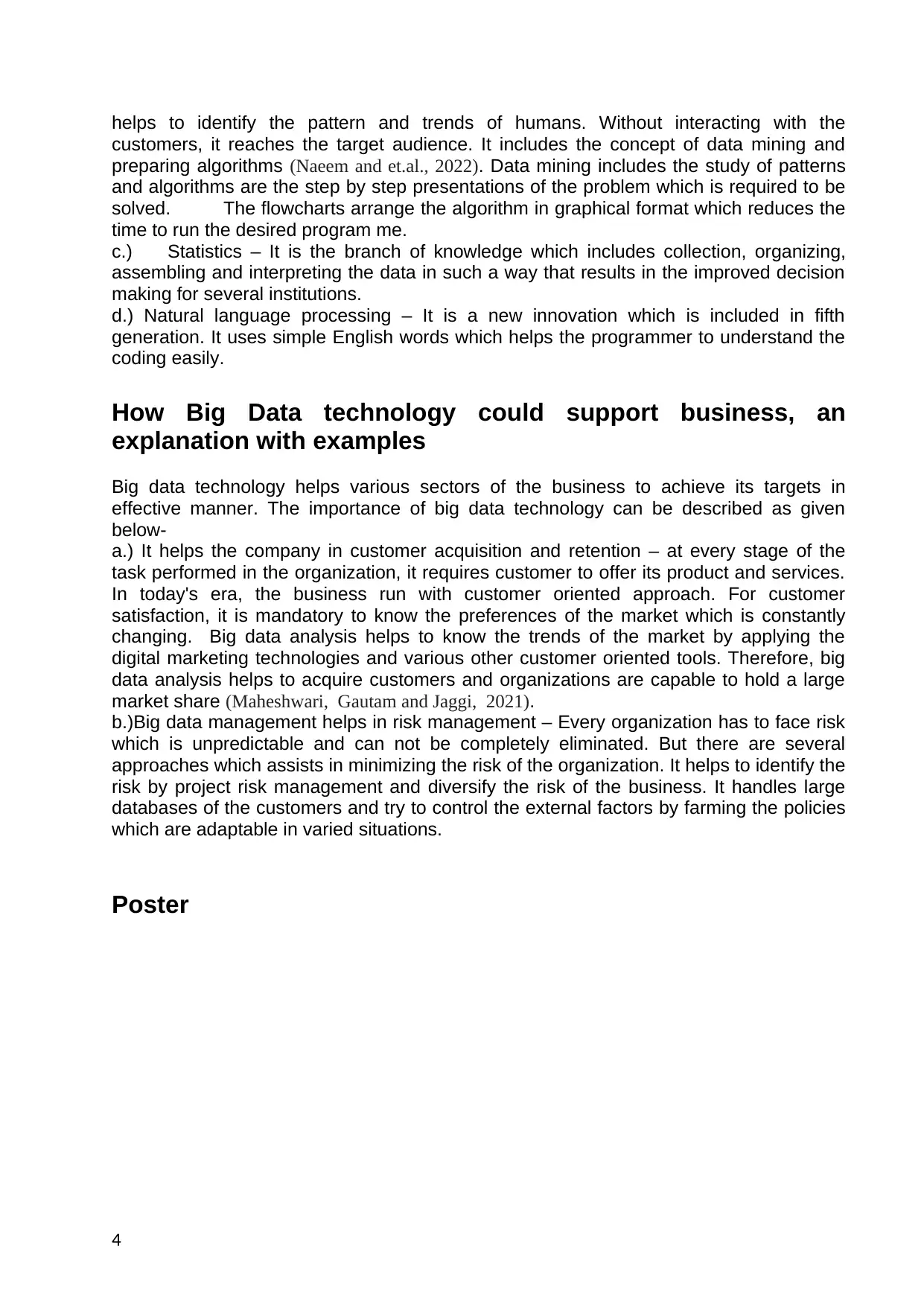
helps to identify the pattern and trends of humans. Without interacting with the
customers, it reaches the target audience. It includes the concept of data mining and
preparing algorithms (Naeem and et.al., 2022). Data mining includes the study of patterns
and algorithms are the step by step presentations of the problem which is required to be
solved. The flowcharts arrange the algorithm in graphical format which reduces the
time to run the desired program me.
c.) Statistics – It is the branch of knowledge which includes collection, organizing,
assembling and interpreting the data in such a way that results in the improved decision
making for several institutions.
d.) Natural language processing – It is a new innovation which is included in fifth
generation. It uses simple English words which helps the programmer to understand the
coding easily.
How Big Data technology could support business, an
explanation with examples
Big data technology helps various sectors of the business to achieve its targets in
effective manner. The importance of big data technology can be described as given
below-
a.) It helps the company in customer acquisition and retention – at every stage of the
task performed in the organization, it requires customer to offer its product and services.
In today's era, the business run with customer oriented approach. For customer
satisfaction, it is mandatory to know the preferences of the market which is constantly
changing. Big data analysis helps to know the trends of the market by applying the
digital marketing technologies and various other customer oriented tools. Therefore, big
data analysis helps to acquire customers and organizations are capable to hold a large
market share (Maheshwari, Gautam and Jaggi, 2021).
b.)Big data management helps in risk management – Every organization has to face risk
which is unpredictable and can not be completely eliminated. But there are several
approaches which assists in minimizing the risk of the organization. It helps to identify the
risk by project risk management and diversify the risk of the business. It handles large
databases of the customers and try to control the external factors by farming the policies
which are adaptable in varied situations.
Poster
4
customers, it reaches the target audience. It includes the concept of data mining and
preparing algorithms (Naeem and et.al., 2022). Data mining includes the study of patterns
and algorithms are the step by step presentations of the problem which is required to be
solved. The flowcharts arrange the algorithm in graphical format which reduces the
time to run the desired program me.
c.) Statistics – It is the branch of knowledge which includes collection, organizing,
assembling and interpreting the data in such a way that results in the improved decision
making for several institutions.
d.) Natural language processing – It is a new innovation which is included in fifth
generation. It uses simple English words which helps the programmer to understand the
coding easily.
How Big Data technology could support business, an
explanation with examples
Big data technology helps various sectors of the business to achieve its targets in
effective manner. The importance of big data technology can be described as given
below-
a.) It helps the company in customer acquisition and retention – at every stage of the
task performed in the organization, it requires customer to offer its product and services.
In today's era, the business run with customer oriented approach. For customer
satisfaction, it is mandatory to know the preferences of the market which is constantly
changing. Big data analysis helps to know the trends of the market by applying the
digital marketing technologies and various other customer oriented tools. Therefore, big
data analysis helps to acquire customers and organizations are capable to hold a large
market share (Maheshwari, Gautam and Jaggi, 2021).
b.)Big data management helps in risk management – Every organization has to face risk
which is unpredictable and can not be completely eliminated. But there are several
approaches which assists in minimizing the risk of the organization. It helps to identify the
risk by project risk management and diversify the risk of the business. It handles large
databases of the customers and try to control the external factors by farming the policies
which are adaptable in varied situations.
Poster
4
Paraphrase This Document
Need a fresh take? Get an instant paraphrase of this document with our AI Paraphraser
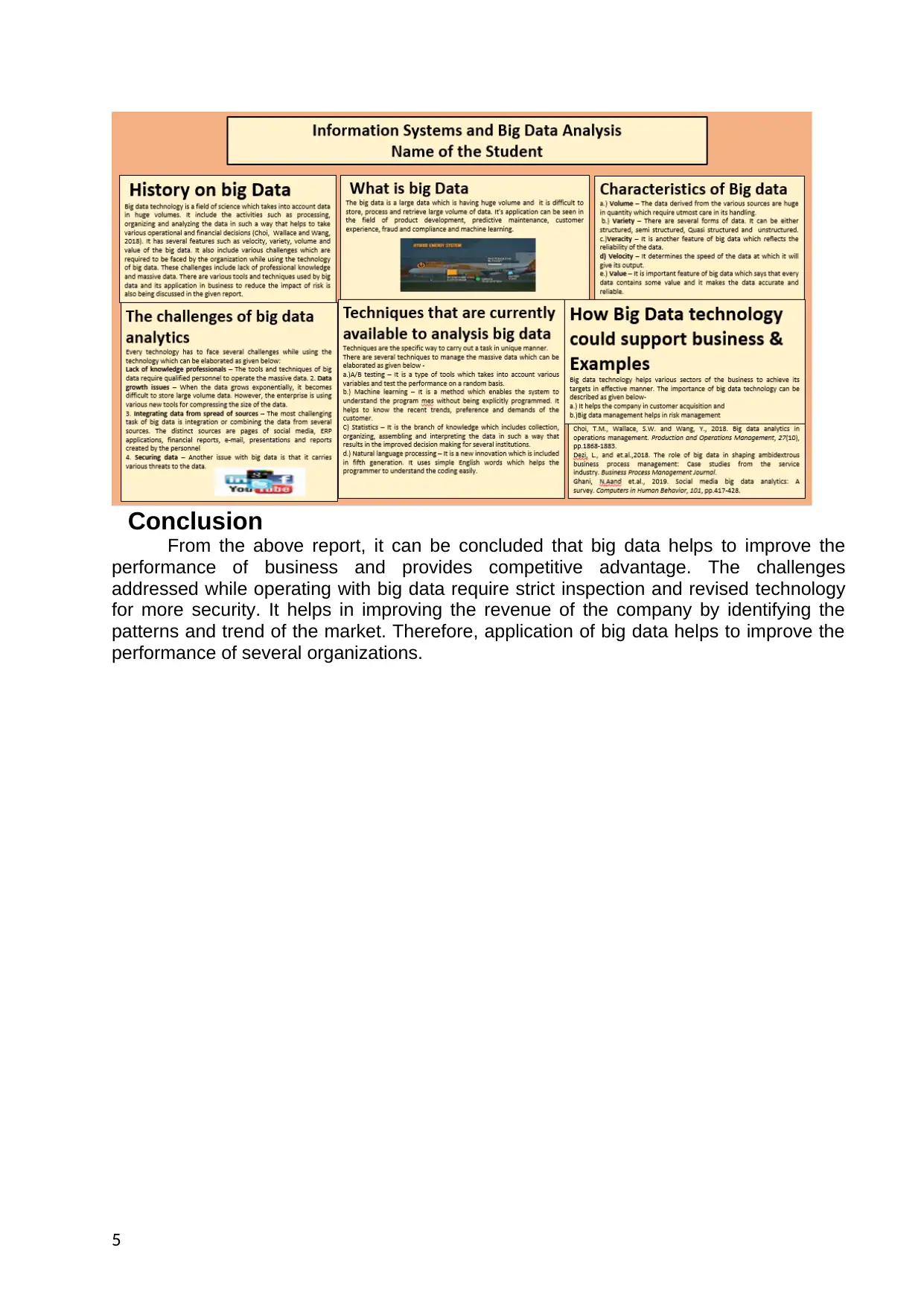
Conclusion
From the above report, it can be concluded that big data helps to improve the
performance of business and provides competitive advantage. The challenges
addressed while operating with big data require strict inspection and revised technology
for more security. It helps in improving the revenue of the company by identifying the
patterns and trend of the market. Therefore, application of big data helps to improve the
performance of several organizations.
5
From the above report, it can be concluded that big data helps to improve the
performance of business and provides competitive advantage. The challenges
addressed while operating with big data require strict inspection and revised technology
for more security. It helps in improving the revenue of the company by identifying the
patterns and trend of the market. Therefore, application of big data helps to improve the
performance of several organizations.
5
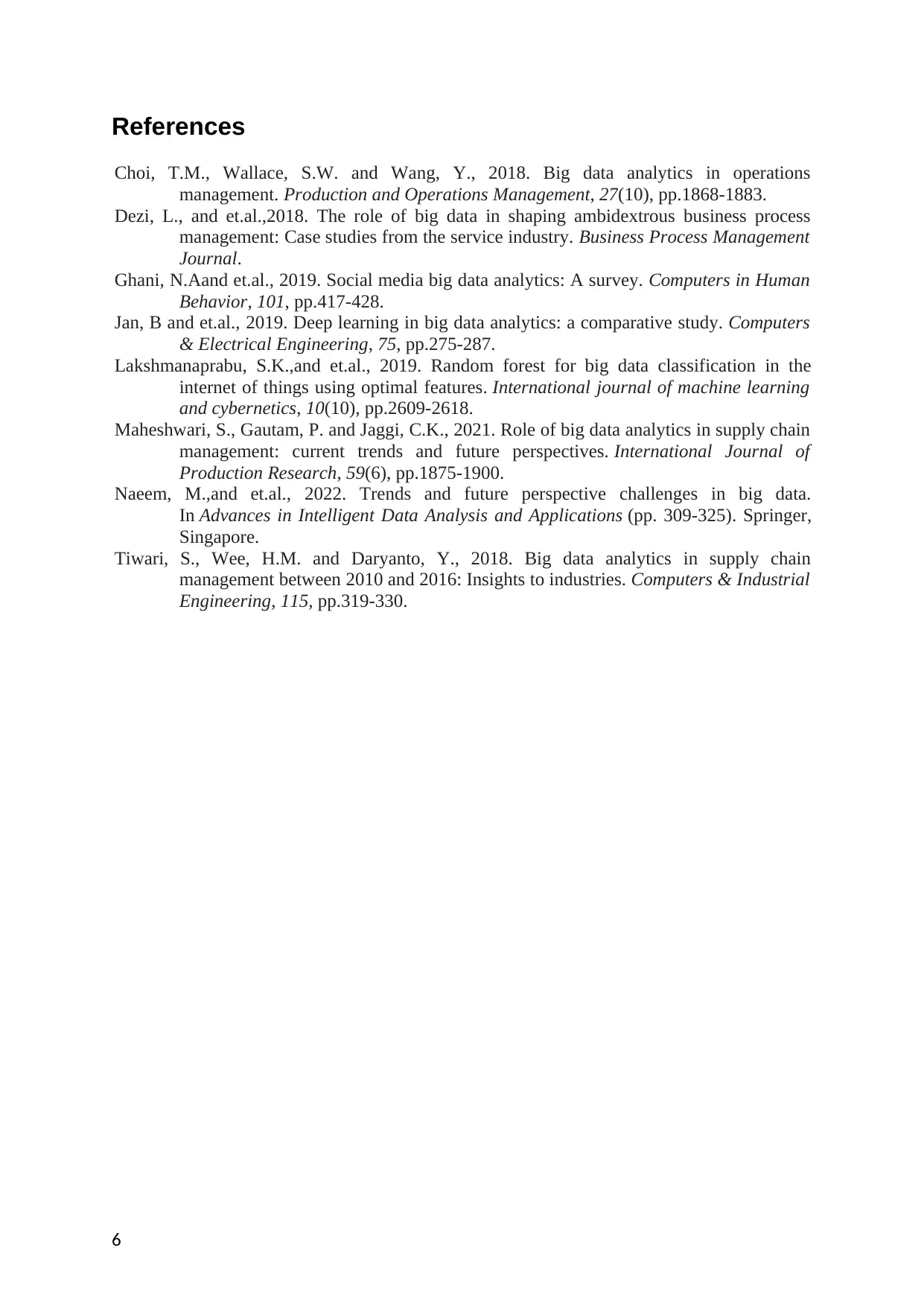
References
Choi, T.M., Wallace, S.W. and Wang, Y., 2018. Big data analytics in operations
management. Production and Operations Management, 27(10), pp.1868-1883.
Dezi, L., and et.al.,2018. The role of big data in shaping ambidextrous business process
management: Case studies from the service industry. Business Process Management
Journal.
Ghani, N.Aand et.al., 2019. Social media big data analytics: A survey. Computers in Human
Behavior, 101, pp.417-428.
Jan, B and et.al., 2019. Deep learning in big data analytics: a comparative study. Computers
& Electrical Engineering, 75, pp.275-287.
Lakshmanaprabu, S.K.,and et.al., 2019. Random forest for big data classification in the
internet of things using optimal features. International journal of machine learning
and cybernetics, 10(10), pp.2609-2618.
Maheshwari, S., Gautam, P. and Jaggi, C.K., 2021. Role of big data analytics in supply chain
management: current trends and future perspectives. International Journal of
Production Research, 59(6), pp.1875-1900.
Naeem, M.,and et.al., 2022. Trends and future perspective challenges in big data.
In Advances in Intelligent Data Analysis and Applications (pp. 309-325). Springer,
Singapore.
Tiwari, S., Wee, H.M. and Daryanto, Y., 2018. Big data analytics in supply chain
management between 2010 and 2016: Insights to industries. Computers & Industrial
Engineering, 115, pp.319-330.
6
Choi, T.M., Wallace, S.W. and Wang, Y., 2018. Big data analytics in operations
management. Production and Operations Management, 27(10), pp.1868-1883.
Dezi, L., and et.al.,2018. The role of big data in shaping ambidextrous business process
management: Case studies from the service industry. Business Process Management
Journal.
Ghani, N.Aand et.al., 2019. Social media big data analytics: A survey. Computers in Human
Behavior, 101, pp.417-428.
Jan, B and et.al., 2019. Deep learning in big data analytics: a comparative study. Computers
& Electrical Engineering, 75, pp.275-287.
Lakshmanaprabu, S.K.,and et.al., 2019. Random forest for big data classification in the
internet of things using optimal features. International journal of machine learning
and cybernetics, 10(10), pp.2609-2618.
Maheshwari, S., Gautam, P. and Jaggi, C.K., 2021. Role of big data analytics in supply chain
management: current trends and future perspectives. International Journal of
Production Research, 59(6), pp.1875-1900.
Naeem, M.,and et.al., 2022. Trends and future perspective challenges in big data.
In Advances in Intelligent Data Analysis and Applications (pp. 309-325). Springer,
Singapore.
Tiwari, S., Wee, H.M. and Daryanto, Y., 2018. Big data analytics in supply chain
management between 2010 and 2016: Insights to industries. Computers & Industrial
Engineering, 115, pp.319-330.
6
⊘ This is a preview!⊘
Do you want full access?
Subscribe today to unlock all pages.

Trusted by 1+ million students worldwide
1 out of 6
Related Documents
Your All-in-One AI-Powered Toolkit for Academic Success.
+13062052269
info@desklib.com
Available 24*7 on WhatsApp / Email
![[object Object]](/_next/static/media/star-bottom.7253800d.svg)
Unlock your academic potential
Copyright © 2020–2025 A2Z Services. All Rights Reserved. Developed and managed by ZUCOL.



